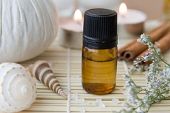Aromatherapy

It is important to understand what is meant by aromatherapy, as well as something of how it works. A popular conception of aromatherapy is as a “massage using essential oil”. Although there is a connection between massage and aromatherapy, it is not strictly correct to define one in terms of the other. Aromatherapy has been defined as “controlled and knowledgeable use of essential oils for therapeutic purposes”. These oils are powerful substances and they should always be handled with care, with professional advice taken where necessary. The essential oils used in aromatherapy are not the same as those used by the perfume and food industries, which standardized or adulterate them for commercial interest. Essential oils for aromatherapy should be natural, with nothing added or taken away.
When essential oils are used for pleasure alone, the choice of oil is usually based on an individual’s preferred aroma, and the properties and effects of the oil are not a priority. However, when used to maintain or improve health, the properties and effects are an important part of the choice. Each essential oil has many properties, and these can affect both body and mind in more than one way. For example, rosemary essential oil has analgesic properties which will benefit headaches, painful digestion and muscular pain. However, rosemary is also a neurotonic, and can relieve general fatigue and stimulate the memory. An enhanced result can often be obtained by selecting and using more than one essential oil (two, three or even four different essential oils can be used to make up the required number of drops). The synergy of the blended oils will result in an increase of energy within the mix, when compared to the energy available from one single essential oil. Having selected the oils you want to use, you need to know the Aromatherapy techniques which will show you how to prepare them for use. The application techniques suitable for use at home are shown in the articles which follow – application to the skin in a carrier oil, which takes the oils into the bloodstream and all around the body, or by inhalation alone. When we breathe in, some essential oil molecules travel to the lungs to be absorbed into the blood. Other molecules go directly to the brain. This is the quickest route and the most effective way to heal weak or fragile emotions and states of mind, such as stress and depression. The nose not only warms and cleans the inhaled air, but it also enables us to identify substances by their smell. Tiny hairs in the human nose, called cilia, send information via receptor cells to the brain to identify the inhaled molecules. The brain then releases neurochemicals, and these have either a sedative or a tonic effect, depending on the aroma.